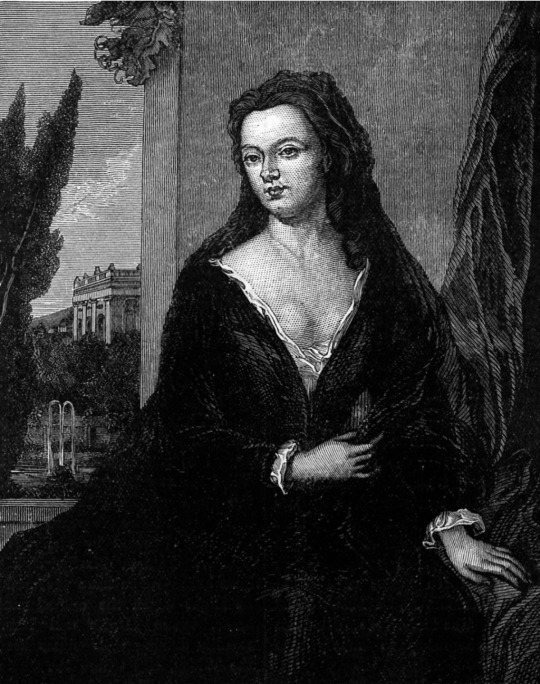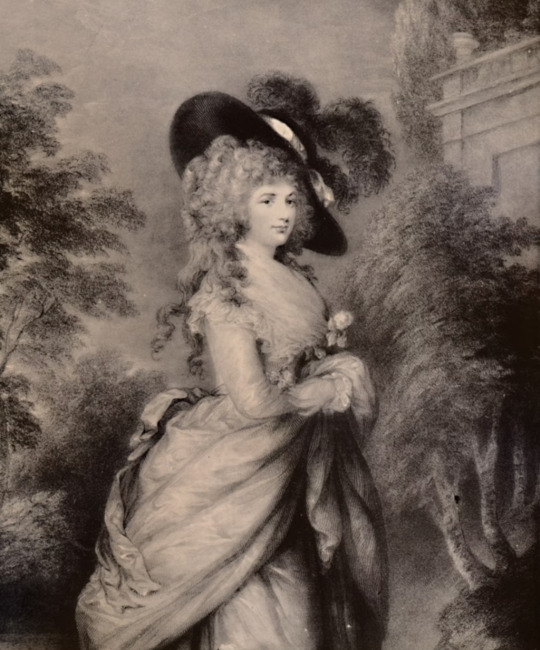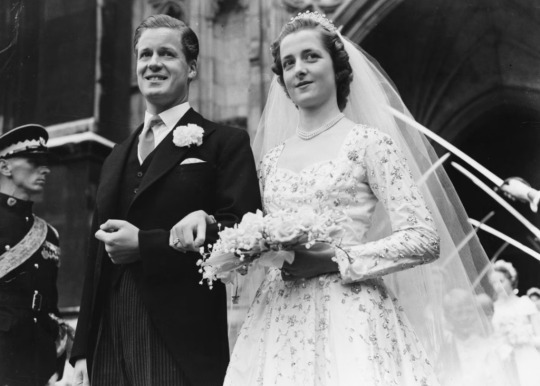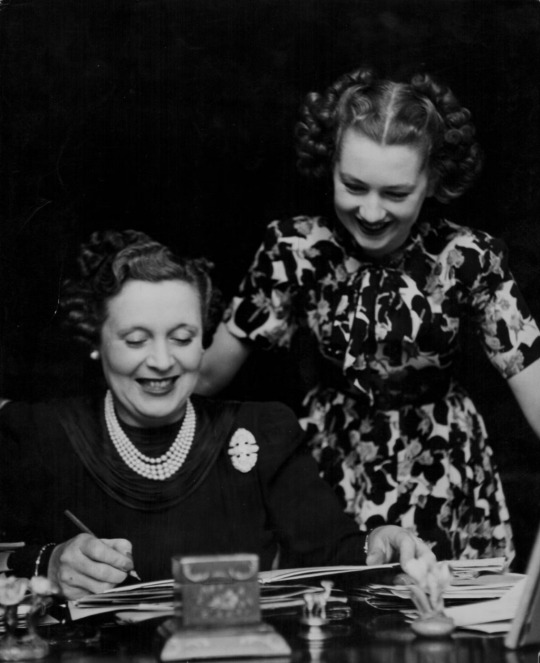#and ended up living with her lovers the Duke and Duchess of Devonshire
Explore tagged Tumblr posts
Text
Actually I do want to clarify that if we were to approach OFMD with like real word logic and historical accuracy Stede and Mary could have separated. Yeah no-fault divorce didn’t exist but people still separated. It wasn’t socially acceptable but neither was running off to become a pirate. Like there were more reasonable and sensible options for Stede but there would be no show if he chose them. You really just have to suspended your disbelief a bit and just take the silly pirate romcom for what it is.
#need I remind you all of Lady Elizabeth Foster who separated from her husband#and ended up living with her lovers the Duke and Duchess of Devonshire#and it was absolutely scandalous but she wasn’t ostracised from society#our flag means death#historical fiction
19 notes
·
View notes
Text
A Brief History of Princess Diana’s Fiery Family
HADLEY HALL MEARES
JUNE 29, 2021 4:04 PM

According to Tina Brown’s The Diana Chronicles. Indeed, the role of the aristocratic family of Diana, Princess of Wales, for centuries has been that of royal disrupter. This legacy stretches to the 14th century, with their disputed ancestor Hugh Despenser’s alleged torrid affair with King Edward II and Despenser’s eventual brutal execution. Clever, charming, and fiery, much like Diana, her ancestors learned how to play the royal game—and then ripped up the rule book.
“Nearly 300 years on, my father would talk about him with an ashamed, resigned chuckle,” Charles, Earl Spencer, writes in The Spencers: A Personal History of an English Family of the mercurial family blackguard Robert Spencer (1641-1702). While the second earl would secure the Spencers’ status as political power players for centuries, he was also “cunning, supple [and] shameless” with “a restless and mischievous temper, a cold heart, and an abject spirt.”
Sunderland’s ascendancy began in the 1670s when he orchestrated King Charles II’s secret pact with England’s traditional enemy, France. Securing large payments from the French king and court for Charles II and himself, Sunderland was rewarded when he was appointed secretary of state.
After double-crossing Charles II’s illegitimate son, the Duke of Monmouth, Sunderland cleverly insinuated himself with new King James II. He converted to Catholicism to appeal to the very Catholic king, and became one of James II’s closest advisers. But the king, though he valued the brilliant man’s diplomatic skills, was fully aware of Sunderland’s duplicity.
James II finally dismissed Sunderland from service in 1688, and he was later exiled. But in December of that year, James II was deposed by the Glorious Revolution, bringing his daughter Mary and her husband, William, Prince of Orange, (with whom Sunderland had conspired) to the throne.
Again in favor, he was rewarded with the post of Lord Chamberlain before retiring from public life in 1697. “Too much cannot be said of his talents,” one historian noted. “Nor too little of his principles.”

The Boss: Sarah Churchill, Duchess of Marlborough
The daughter of Parliamentarian Richard Jennings and his scandalous wife, Frances, the passionate, brilliant Sarah (1660-1744) started out as a maid of honor in the court of James II. She became the most powerful woman in England, through her magnetic control of the future Queen Anne, a comparative dullard who worshipped her and perhaps became her lover. (You may remember their relationship from the 2018 movie The Favourite, in which Rachel Weisz played Sarah.)
For Sarah, her friendship with Anne was a way to advance her family and her liberal Whig politics, which she shared with her equally powerful husband, the military hero the Duke of Marlborough. “I hated tyranny by nature,” she wrote in one version of her memoir, according to Ophelia Field’s The Favourite: The Life of Sarah Churchill. “I thought mankind was born free, & if Princes were ordained to make their subjects happy; so I had always in me an invincible aversion to slavery, & to flattery.”
In 1700, Sarah arranged the marriage of her distant relation Charles Spencer, the future Third Earl of Sunderland, with her favorite daughter, Anne. Over the next 44 years, she would shape the family fortunes—and gift them with their famed auburn-tinted locks.
According to The Favourite: The Life of Sarah Churchill, with Anne’s accession to the throne in 1702 Sarah reached the peak of her power, racking up virtually every important post in Queen Anne’s suite, dictating cabinet appointments, and encouraging the ire of satirists.
But cracks would soon begin to appear. Queen Anne was naturally inclined to support the royalist Tories and was encouraged in these leanings by a new favorite named Abigail. A vindictive Sarah became a master propagandist, leaking insinuations about their relationship to the press, and allegedly threatening to blackmail Anne over the contents of their highly charged correspondence.
Sarah was finally forced to vacate her royal apartments in 1711, but she was not down for the count. A brilliant businesswoman, she became the richest woman in England, according to Field, controlling her Spencer grandchildren with promises of money and power. Centuries before the modern Diana and Prince Charles wed, Sarah even attempted to marry her favorite granddaughter—Lady Diana Spencer—to the broke Frederick, Prince of Wales, with a promise of 100,000-pound dowry. The plan fell through.
But not all her grandchildren were willing to be manipulated by their formidable matriarch. Sarah claimed her equally tough granddaughter Anne “[deserved] to be burnt,” and she disinherited her grandson Charles, Fifth Earl of Sunderland, which prompted him to write her:

As for putting me out of your will…I neither expected or desired to be in it. I…assure Your Grace that this is the last time I shall ever trouble you by letter or conversation. I am Your Grace’s grandson, Sunderland.
Sarah’s letter back was brutal. “You end that you are my grandson. Which is indeed a very melancholy truth…had you not been my grandson, you would have been in as bad a condition as you deserve to be.” Fitting words from a woman immortalized by Alexander Pope thusly:
Sixty years the World has been her Trade, The wisest Fool much Time has ever made. From loveless youth to unrespected age, No Passion gratify’d except her Rage.
The Star: Georgiana Cavendish, Duchess of Devonshire
From the start there was something special about Georgiana (1757-1806), the coddled daughter of John, First Earl Spencer and his wife, Margaret. The captivating teenager married the sophisticated William, Duke of Devonshire, in 1774, and quickly became a sensation in London’s highest circles. “[The Duchess of Devonshire] effaces all,” Horace Walpole wrote, according to The Devonshires: The Story of a Family and a Nation. “Her youth, figure, flowing good nature, sense…and modest familiarity, make her a phenomenon.”
Georgiana soon found her cold, older husband was not nearly as interested in her as everyone else. Luckily, she had many talents with which to amuse herself. She set fashions of the day, developed her own haughty way of speaking, known as the “Cavendish drawl,” and became dear friends with Marie Antoinette, according to Amanda Foreman’s The Duchess. She was also a successful novelist, and an amateur scientist.
But it was Georgiana’s brilliance as a Whig operative that would turn her into a target of the press. Constantly brainstorming with her friend, George, Prince of Wales, and political soulmate Charles James Fox, she hosted countless summits at her home. Georgiana was, she later wrote, “in the midst of the action,” seeing
“partys rise and fall—friends be united and disunited—the ties of love give way to caprice, to interest, and to vanity…”
Georgiana also worked essentially as a campaign manager for Whig candidates. During the 1784 election she bravely canvassed the street for Fox, charming Londoners with her common touch. “During her canvass,” Walpole wrote, “the Duchess made no scruple of visiting some of the humblest of electors, dazzling and enchanting them by the fascination of her manner, the power of her beauty and the influence of her high rank.”
According to Foreman’s The Duchess, there were rumors Georgiana kissed men in exchange for votes, leading to scurrilous cartoons distributed by the Tory opposition. “You have almost unavoidably amassed a great deal of useless trash—gathered weeds instead of flowers,” Lady Spencer wrote Georgiana. “You live so constantly in public you cannot live for your own soul.”
Her mother was worried about more than bad press. The hard-partying Georgiana was one of a long line of Spencer gambling addicts. She also had a laudanum dependency, and a scandalous ménage à trois arrangement with her husband and the disreputable Bess Foster. Calamity struck in 1792, when Georgiana became pregnant by the future Prime Minister Charles Grey and was banished from the country for a while.
Georgiana returned to her husband and children two years later. For the remainder of her life she battled ill health, but continued her role as a political operative, aware of what she could have been. “Would I were a man,” she mused to Sir Philip Francis. “To unite my talents, my hopes, my fortune, with [Charles James Fox’s], to make common cause, and fall or rule.”

From the start, the Spencer legacy laid heavily on John Spencer’s (1924-1992)
shoulders. As a child he was constantly cowed by his genealogically obsessed, brutal father, who considered him an intellectual lightweight. “He used to dread the train journey home [from boarding school],” his son, Diana’s brother Charles, writes. “He would hide in shadows of the train carriage, hoping his father had forgotten to collect him.”
But by the 1940s, John’s heroism as a captain in the Royal Scots Greys during World War II, and his tall, good looks and simple charm made him a most eligible bachelor. According to the documentary When the Spencers Met the Monarchy, he was even once looked at by the palace as a suitor to the future Queen Elizabeth II.
Instead, in 1954, Queen Elizabeth II (whom he served as an equerry) attended his wedding to heiress Frances Roche at Westminster Abbey. The couple had four children—Sarah, Jane, Diana, and Charles (another son, John, died shortly after birth). They were a mismatched pair, he rather dull and she vivacious, but John was reportedly blindsided when he discovered Frances was cheating on him. “How many of those years were happy?” he later said of his marriage. “I thought all of them until the moment that we parted.”
After the dissolution of his marriage, John became Diana and Charles’s primary caregiver and developed what Lord Glenconner once termed “an unfortunate raw sausage look.” Although he was stiff and old-fashioned, he attempted to be an involved father, and Diana was determined to be his “comforting angel,” according to The Diana Chronicles.
In 1975, John’s fortunes turned when his curmudgeonly father died, making him the Eighth Earl Spencer. According to Andrew Morton, he also inherited a 2.25-million-pound bill for death duties as well as 80,000-pounds-a-year running costs for Althorp, the family estate in Northamptonshire. He also found a helpmate to run Althorp in the fascinating Raine, Countess of Dartmouth, whom he married in 1976 without even telling his children. “We weren’t invited. ‘Not grand enough,’” his daughter Sarah quipped to a reporter at the time.
Despite the flippant tone, John’s betrayal would cause a deep rift in the family. A severe stroke in 1978 caused him to become frail and even more distant from his children. “He was one person before and he was certainly a different person after,” Princess Diana said, according to Morton. “He’s remained estranged but adoring since. If he comes and sees me he comes and sees me, if he doesn’t he doesn’t. It’s not my problem anymore. It’s his.”

The Rebel: Frances Shand Kydd
Frances Ruth Roche (1936-2004) wasn’t from as noble stock as the Spencers, but her family was far richer. Her father Maurice, fourth Baron Fermoy, was a conservative politician and a “terrible bottom pincher,” Lady Glenconner says in The Diana Chronicles, while her wealthy mother, Ruth, was a scheming, incurable snob and great friend of Elizabeth, the Queen Mother.
It was Ruth who encouraged a teenage Frances to marry the much older John Spencer, despite her tender age. “When you meet someone at the age of 15 and get engaged just five months out of school at 17, you can look back and ask, ‘Was I adult?’” she asked years later. “I sure thought I was at the time.”
The couple cultivated a farm at her family home of Park House in Norfolk, but Frances was quickly disillusioned with life in the country as a young aristocratic mother. “I’m so bloody bored with opening village fetes,” she told a friend. It was no wonder that the fiery Frances wanted more. “She was very attractive and blonde and sexy with such joie de vivre and fun about her,” a friend told Brown, author of The Diana Chronicles.
By the 1960s, Frances escaped to London more and more. She also started having an affair with a married bon vivant named Peter Shand Kydd. In 1967, she separated from John and left her two youngest children with him. “The biggest disruption was when Mummy decided to leg it. That’s the vivid memory we have—the four of us,” Princess Diana later told Andrew Morton.
Frances fought for custody of the children but lost to John, partially due to her own mother, Baroness Fermoy, who testified against her. Social outcasts, the Shand Kydds eventually moved to the coast of Scotland, and their warm household was a refuge for her children when they were allowed to visit. “Diana and I adored it for its wild beauty and the fun we had on the sea, lobster potting and mackerel-fishing,” Charles Spencer recalls.

Frances counseled against her youngest daughter’s marriage to Prince Charles, seeing too many parallels to her own first marriage—including her mother’s encouragement of the match. According to Brown, after voicing her concerns, Diana said, “Mummy, you don’t understand. I love him.” Frances replied, “Love him, or love what he is?” To which Diana asked rhetorically, “What’s the difference?”

The Grande Dames: Barbara Cartland and Raine Spencer
Perhaps no writer influenced generations of British romantics—including Princess Diana—more than Barbara Cartland (1901-2000). The author of 723 books, Cartland had, in the words of Brown, a “penchant for pink, her meringue coiffure and false eyelashes,” which betrayed a steely, snobbish character that was tough as nails.
Cartland would pass both her strength and outrageousness on to her daughter Raine (1929-2016), whom she raised to be, in Brown’s words, a “social monster baby.” Not only did she nab Gerald Legge, Ninth Earl of Dartmouth, but she also forged a career as a conservative politician, becoming the youngest person to ever serve on the Westminster City Council.
“She never took any prisoners, and never took no for an answer,” a friend recalled.
In the early 1970s, Raine set her sights on the divorced John Spencer. “She wanted to marry Daddy; that was her target and that was it,” Princess Diana recalled. According to sources, “Acid Raine” alienated the children and old friends. She also took the reins of Althorp, allegedly selling off family treasures and decorating it in her and her mother’s garish style.
During the lead-up to Diana’s wedding to Prince Charles in 1981, what to do with the clownish Cartlands became a national conversation. According to Brown:
Alexander Chancellor, the editor of The Spectator, wrote an editorial in which he called for a special Act of Parliament to ban Raine and her mother from St. Paul’s Cathedral, adding, “For it would be more than a little unfair on everybody if these two absurdly theatrical ladies were permitted to turn a moving national celebration into a pantomime.” Diana was so afraid the pantomime might indeed take place, she pressed for stratagems to blackball Cartland.
In the end Raine was invited but her mother was not. This would not be the most awkward Spencer wedding—that prize would go to Charles Spencer’s first wedding in 1989, where Diana scolded Raine for her rudeness to their mother. “If only you knew how much we all hated you for what you’ve done, you’ve ruined the house, you spend Daddy’s money and what for?” she hissed.
For her part, Raine would tire of being the scapegoat for the Spencer dysfunction. “I’m absolutely sick of the ‘wicked stepmother’ lark,” she said, according to Kitty Kelley. “You’re never going to make me sound like a human being, because people like to think I’m Dracula’s mother.”
Surprisingly, Diana would come to agree. Toward the end of her life, she grew close to her stepmother, whose no-nonsense advice she came to admire. However, it appears there was no love lost between Diana and her former favorite writer, who would quip of the royal breakup, “Of course, you know where it all went wrong. She wouldn’t do oral sex.”
The Role Model: Lady Sarah McCorquodale

Born in 1955, Sarah Spencer was the oldest, and wildest of John and Frances Spencer’s brood. Reckless and salty from an early age, Brown writes that she was kicked out of boarding school and rode her horse into her grandmother’s living room. “Sarah always had to be the best at everything,” a friend recalled. “The best car, the wittiest put-down, and the best dress.”
She also had a constant shadow in her youngest sister, Diana. “I idolized my eldest sister and I used to do all her washing when she came back from school. I packed her suitcase, ran her bath, made her bed—the whole lot. I did it all and I thought it was wonderful,” Diana told Morton.
In 1977, Sarah, who had suffered from anorexia, according to Brown, met Prince Charles at Ascot. The two began dating, and it was Sarah who introduced Diana to the prince during a shooting party at Althorp (“I’m cupid,” she’d later quip). “I remember,” Diana later said, “feeling desperately sorry for him that my sister was wrapped around his neck because she’s quite a tough old thing.”
But Sarah’s romance with the prince would soon end. She made the mistake of talking to reporters. Not only did she reportedly confess to having “thousands of boyfriends,” she also disparaged Charles as a hopeless romantic. “I wouldn’t marry a man I didn’t love, whether it was a dustman or the King of England,” she said. “If he asked me I would turn him down.”
This cardinal sin would cause Sarah to be promptly frozen out, with Charles reportedly informing her, “You’ve just done something extremely stupid.” And so, only three years later Charles would begin to court the blossoming Diana. Perhaps there was a hint of jealousy in her alleged counsel to a despondent Diana to not pull out of the wedding over his relationship with Camilla: “Bad luck, ‘Duch. Your face is on the tea towels so you’re too late to chicken out.”
#princess diana#lady diana spencer#the spencers#the spencer family#a brief history into princess Diana's fiery family
19 notes
·
View notes
Photo


Victoria Windsor - 𝒇𝒂𝒎𝒐𝒖𝒔 & 𝔦𝔫𝔣𝔞𝔪𝔬𝔲𝔰
Meet the famous Cecily Cavendish
Cecily Cavendish was the daughter of the Duke and Duchess of Devonshire, a powerful noble family and close friends of the crown. As a result, Cecily was brought up in close proximity to the royal children. Originally intended as a playmate for the princesses, she in fact ended up forming strong relationships with all the young Windsors. Gentle and sweet, she spent the majority of her childhood in the royal palace rather than her own home, close to the Windsors than she ever was the Cavendishes.
As a teenager, Cecily fell in love with the crown prince of England. he reciprocated her feelings, and the King and Queen, out of fondness for the girl they already loved as a daughter, granted them permission to wed, and the two became engaged as soon as they came of age.
Prior to the wedding, the Crown Prince was called away to a foreign country on official matters. Whilst returning to England, his retinue was ambushed by hostile forces. Only a few men escaped. They didn’t know if the prince was dead or alive, nor who their assailants were. The prince was missing, and though the King and Queen searched frantically, there was no clues to his whereabouts - none but a letter, arriving mysteriously at the palace with his ring in the envelope, declaring him to be dead.
England had no choice but to accept that their prince would never return to them - but Cecily refused to. Distraught by the mere suggestion of his demise, she refused to marry another, refused to move on with her life, and refused to give up hope that her betrothed would not be returning to her.
After several years, England was plunged into shock when their prince returned alive and well. Cecily was finally able to marry the an she loved, ho she had never given up on. Her loyalty to her fiancé earned her the nickname “the patient princess”.
Cecily is held up as a model of true love by many romantics in England, with young lovers across the country taking inspiration in the story of Lady Cavendish and her prince. The two went on to rule the country together, and are known to history as two of the most beloved and popular monarchs in English history.
Meet the Infamous King Henry X
When Henry was born, it seemed unlikely he would ever ascend the throne. His grandfather was the ruling monarch, but Henry was the child of the king’s second son, and his uncle, The crown prince, has four children of his own. Being seventh in line, Henry was fated to be little more than a forgotten duke, whose lineage would eventually fade into obscurity.
That all changed when Henry was 10 years old. A sickness ravaged through England, attacking noble and peasant alike. The royal family wasn’t spared tragedy. Within three days of one another, the crown prince, all of his four children, and the king himself were dead. Three weeks after that, Henry’s father passed away too. At 10 years old, Henry was crowned King Henry X of England.
Underage, and with no parents to fight for his rights, Henry spent the remainder of his childhood and teenage years as a glorified hostage. Nobles, grasping for power, fought each other for control of him, and he was afforded little freedoms nor choice. By the time he came of age, he was a mistrustful, paranoid young man with a cold and callous heart.
Henry was determined not to fall victim to the manipulations and control of others again. He was the king, and he would have absolute power. He reigned for 27 years in total, in which time, he became a tyrant, dissolving parliament to rule absolutely, spending the treasury on his own whims, and doing little in the way of actual governance. During that time, England descended into chaos.
It was his brother who brought him down, in the end. Richard Windsor was far more just and responsible than his brother, and, with the support of a coalition of nobles, eventually stormed his brother’s palace and forced him to abdicate. Richard went on to become King Richard IV, and spent the bulk of his reign trying to bring stability to England once more. Henry himself lived out his remaining 20 years in prison. Whilst restrictions were initially tight, he was eventually afforded freedoms, and was allowed to wonder throughout the castle he was held at and its grounds at will. He grew into a solitary figure, and spent his days drawing and gardening. He died at 57 of natural causes.
1 note
·
View note